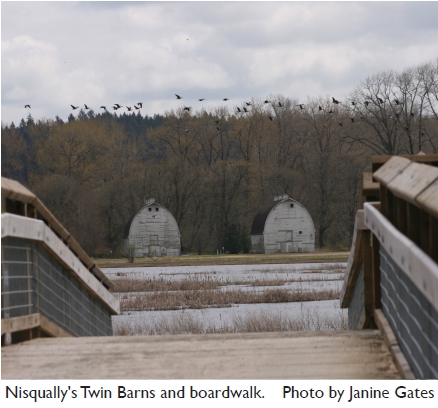Fair Weather Hikers: You Don't Have to Go Farby Steve Robinson
Now that the boardwalk trail is built at the Nisqually National Wildlife Refuge, you can find such joy just outside the overbuilt city of Lacey at the Nisqually Estuary. The boardwalk makes a delightful stroll for those who don't have the time to go far, and who realize they don't have to, but who crave to see one of the most beautiful spots in one of the most beautiful of states. More than 200 people came out to dedicate the new mile long boardwalk this past winter, and they weren't disappointed when they beheld what is possibly the longest boardwalk on the West Coast The trail features an observation tower, an enclosed viewing platform, several push-outs for those who want to linger with their binoculars and two covered viewing platforms. There are thoughtful touches like the areas with lower railings and mesh coverings to allow unobstructed views for kids and people in wheelchairs. One highlight is the Puget Sound Viewing Platform at the end of the boardwalk as it provides a 360-degree view of McAllister Creek, the Olympics, Mount Rainier and several islands in the Puget Sound. Many think the new boardwalk was the culmination of a three-year project to restore the estuary with natural tidal flow, as it followed the removal of the Brown Farm Dike in 2009. But, in reality, the project began many more years ago, as part of a project led by the Nisqually Tribe to overhaul the ecosystem of the entire river. For thousands of years, the Nisqually River watershed has been home to the Nisqually Indian people. It has provided food in the form of salmon and other fish that filled the waters and shellfish when the tide went out. Deer and other game in the river's surrounding forests further nurtured the people, enriched by a diet of berries, roots, and herbaceous plants. As described by Northwest Indian Fisheries Commission Chairman Billy Frank, Jr.'s late father, Willy Frank, Sr. in the movie, As Long As the Rivers Run, it indeed was a "paradise." The settlers moving in from the 1850s on decided to mold the area into their own version of what they thought a watershed should look like. They diked the estuary area for agricultural purposes, channelized the river in other areas, and greatly altered the natural habitat and the earlier natural balance. But over the past three decades, a collective effort involving jurisdictions and neighbors from all vocations and ethnic backgrounds have worked together with the Tribe at the helm in a successful effort to return the Nisqually estuary to its natural condition. The Tribe's leadership role was forged through a combination of cooperative partnerships, and litigation, reestablishing Northwest tribes' legitimate place as resource managers. This movement began to return some of the land ethics to modern management, even if it is sometimes difficult to see in the efforts of local jurisdictions and the legislature. Having the Nisqually Tribe at the helm of this restoration effort has been meaningful in many ways, and not only the estuary has benefited from the ensuing spirit of cooperation. The mainstem of the river, and its tributaries, have been cleaned up, riprap removed and replaced by logs that provide nutrients to the water and hiding places for fish. Old problems with Fort Lewis have been dealt with, such as tanks crossing through water; cities, farmers, ranchers, foresters and other property owners have cooperated and the upper river, near Ohop, is being reconverted from a drainage ditch to a natural, meandering river. The overall Nisqually is a shining example of the benefits of cooperation, and even though it's close by, it provides many outstanding locations for outdoor enthusiasts to enjoy as we near the summer months. For more information on the Nisqually, see "The Return of a River: A Nisqually Tribal Challenge," the new Evergreen State College case study by Steve Robinson and Michael Alesko at http://www.evergreen.edu/tribal/docs/Robinson-Alesko%20Nisqually30611.pdf Steve Robinson is a SPEECH board member and owner of SR Productions, a full service public affairs company. He is a former newspaper reporter and public affairs director for the Department of Natural Resources and the Northwest Indian Fisheries Commission.
Back to Home page. |

 One of the great things about living in the Northwest is you really don't have to travel far to be in paradise -- a place where the pure scent of a freshly returned tide envelopes you and birds and animals dart about in their daily routine of work and play. You really don't have to go far to witness the circle of life in action, as otter play tag and eagles swoop down to select from a host of quiescent salmon, or just watch the sun settle into a horizon of snow-capped mountains, bidding you good evening as it gives way to another night of starlit glory.
One of the great things about living in the Northwest is you really don't have to travel far to be in paradise -- a place where the pure scent of a freshly returned tide envelopes you and birds and animals dart about in their daily routine of work and play. You really don't have to go far to witness the circle of life in action, as otter play tag and eagles swoop down to select from a host of quiescent salmon, or just watch the sun settle into a horizon of snow-capped mountains, bidding you good evening as it gives way to another night of starlit glory.